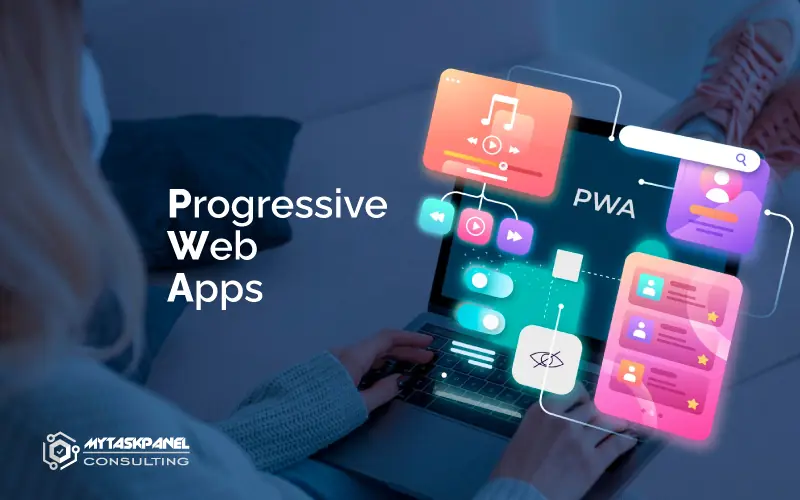Progressive web applications (PWAs) have revolutionized the way we interact with applications on our mobile and desktop devices. These applications combine the best of websites and native apps, offering a seamless, fast, and reliable user experience. Unlike native apps, they don’t need to be downloaded and installed from an app store; instead, they are accessed through a web browser. In this article, we’ll tell you everything you should know about progressive web apps.
Key features of PWAs
- Connectivity. One of the most prominent features of PWAs is their ability to function offline or on weak network connections. Thanks to Service Workers, web browsers can cache the necessary resources for the application to run smoothly, allowing users to access content even when there’s no stable connection.
- Responsive design. PWAs are designed to adapt to any device, whether it’s a mobile phone, tablet, or desktop computer. This means that users can enjoy a consistent and optimized experience regardless of the device they are using.
- Automatic updates. Unlike native apps, which require manual updates through an app store, PWAs update automatically. This ensures that users always have access to the latest version of the application without needing to take any additional action.
- Native interaction. PWAs allow developers to leverage the native capabilities of devices, such as push notifications, access to the camera and microphone, and geolocation. This creates a user experience similar to that of a native app without the need to develop and maintain different versions for each platform.
3 key benefits of progressive web apps
- Greater reach. Since PWAs don’t rely on app stores, they are easily accessible through a web browser. This eliminates the barriers of downloading and installation, expanding the application’s reach and allowing users to access it with just one click.
- Space and cost savings. PWAs don’t require traditional installation, so they don’t take up space on the user’s device. Additionally, by not needing to develop and maintain multiple versions for different platforms, development costs are significantly reduced.
- Enhanced SEO. PWAs are easily indexable by search engines, meaning they can appear in search results and attract new users. This improves the application’s visibility and can generate more traffic.
5 Drawbacks of PWAs
- Dependency on connection. This type of application requires a good internet connection to function fully.
- Limited compatibility. They may not be compatible with older browsers, limiting their potential audience.
- Reduced native experience. PWAs don’t leverage all of the device’s capabilities like a native app.
- Local storage. Over time, they can occupy space on the device due to local data storage.
- Lower visibility. They are not distributed through popular app stores, which can make them harder for users to discover.
Tools and technologies for PWA development
- Service Workers. Service Workers are a fundamental technology for PWAs. These scripts run in the background and enable applications to handle events such as receiving push notifications, automatic updates, and caching resources for offline operation.
- Manifest JSON. The Manifest JSON file is an essential part of PWAs, defining information such as the app’s name, home screen icon, theme colors, and more. This helps the app behave like a native application and provides a consistent experience on the user’s device.
- Frameworks and libraries. There are several popular frameworks and libraries that simplify PWA development, including React, Angular, and Vue.js. These tools offer reusable components, routing, and state management, speeding up the development process and improving efficiency.
- Web APIs and technologies. PWAs can leverage modern web APIs and technologies to provide a richer experience. This includes using the push notification API to send alerts to users, the geolocation API to customize the experience based on the user’s location, and the caching API to enable offline functionality.
4 best practices for progressive web apps development
- User-centered design. Just like with any application, it’s crucial to consider the needs and expectations of users when designing a PWA. This involves creating an intuitive interface, ensuring fast performance, and prioritizing core functionality.
- Performance optimization. PWAs should be fast and responsive. This involves optimizing load times, minimizing resource usage, and reducing downtime to a minimum. Application performance is critical for a satisfactory user experience.
- Security and privacy. When dealing with user data, it’s essential to ensure the security and privacy of information. Use secure connections via HTTPS and ensure compliance with applicable data protection regulations.
- Comprehensive testing. Conduct thorough testing on different devices and browsers to ensure that the PWA functions correctly on all platforms. This includes testing offline functionality, compatibility with various screen resolutions, and the user experience on different operating systems.
The promising future of PWAs
As web technologies continue to evolve, progressive web applications are emerging as the future of the user experience on both mobile and desktop devices. Their ability to offer an experience similar to native apps, combined with their accessibility and ease of development, makes them an attractive choice for businesses and developers.
With the advancement of technologies and widespread adoption of PWAs, we are likely to see a significant increase in their popularity and usage.
Trends and developments in this field
- Increased platform support. As PWAs continue to gain momentum, we may see greater support from major platforms like iOS and Android. This will enable smoother integration and easier access to device functionalities.
- Enhanced functionality. As web APIs and technologies continue to evolve, PWAs will be able to leverage the device’s capabilities even further, providing a richer and more personalized experience. Advances in areas like augmented reality, facial recognition, and voice recognition are expected.
- E-commerce and mobile payments. PWAs are particularly well-suited for e-commerce, allowing users to make quick and convenient purchases without the need to install additional apps. We’ll see a greater focus on PWA development for e-commerce and the integration of mobile payment solutions.
- Integration with virtual assistants. As virtual assistants like Siri, Google assistant, and Alexa become more popular, PWAs will be able to integrate more closely with these systems. This will enable users to interact with applications through voice commands and receive instant responses.
In summary, the development of progressive web applications offers an innovative and powerful alternative to traditional apps. By combining the best of websites and native apps, PWAs provide an acceptable user experience at a much lower development cost. With the ongoing advancement of web technologies and growing platform support, it’s safe to say that PWAs have a bright future ahead.










